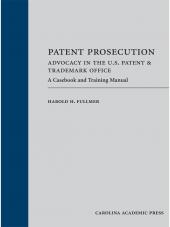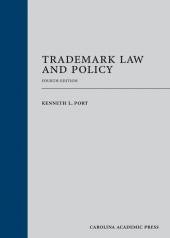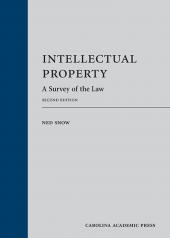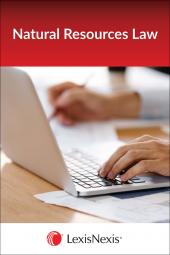Patent Prosecution: Advocacy in the U.S. Patent & Trademark Office
Select subscription type
Terms & conditions
Subscribers receive the product(s) listed on the Order Form and any Updates made available during the annual subscription period. Shipping and handling fees are not included in the annual price.
Subscribers are advised of the number of Updates that were made to the particular publication the prior year. The number of Updates may vary due to developments in the law and other publishing issues, but subscribers may use this as a rough estimate of future shipments. Subscribers may call Customer Support at 800-833-9844 for additional information.
Subscribers may cancel this subscription by: calling Customer Support at 800-833-9844; emailing customer.support@lexisnexis.com; or returning the invoice marked "CANCEL".
If subscribers cancel within 30 days after the product is ordered or received and return the product at their expense, then they will receive a full credit of the price for the annual subscription.
If subscribers cancel between 31 and 60 days after the invoice date and return the product at their expense, then they will receive a 5/6th credit of the price for the annual subscription. No credit will be given for cancellations more than 60 days after the invoice date. To receive any credit, subscriber must return all product(s) shipped during the year at their expense within the applicable cancellation period listed above.
Subscribers receive the product(s) listed on the Order Form and any Updates made available during the annual subscription period. Shipping and handling fees are not included in the annual price.
Subscribers are advised of the number of Updates that were made to the particular publication the prior year. The number of Updates may vary due to developments in the law and other publishing issues, but subscribers may use this as a rough estimate of future shipments. Subscribers may call Customer Support at 800-833-9844 for additional information.
Subscribers may cancel this subscription by: calling Customer Support at 800-833-9844; emailing customer.support@lexisnexis.com; or returning the invoice marked 'CANCEL'.
If subscribers cancel within 30 days after the product is ordered or received and return the product at their expense, then they will receive a full credit of the price for the annual subscription.
If subscribers cancel between 31 and 60 days after the invoice date and return the product at their expense, then they will receive a 5/6th credit of the price for the annual subscription. No credit will be given for cancellations more than 60 days after the invoice date. To receive any credit, subscriber must return all product(s) shipped during the year at their expense within the applicable cancellation period listed above.
Product description
epub is protected by Adobe DRM.
eBooks, CDs, downloadable content, and software purchases are noncancelable, nonrefundable and nonreturnable. Click here for more information about LexisNexis eBooks. The eBook versions of this title may feature links to Lexis+® for further legal research options. A valid subscription to Lexis+® is required to access this content.
Table of contents
Chapter 1 PREFACE
Chapter 2 INTRODUCTION
A. AN INVENTION CASE STUDY
Adam Mossoff, The Rise and Fall of the First American Patent Thicket: The Sewing Machine War of the 1850s
B. REVIEW OF SOME BASICS
1. Patents Rights are Statutory
2. Patents Protect Inventions
3. A Right to Exclude, Not a Right to Practice
4. Patents are Territorial
5. Utility Patent Applications: Provisional and Non-Provisional
6. Filing Date and Right of Priority
Problem
7. Patent Applications Publish 18 Months from the Earliest Priority Date
Problem
8. Example of the Use of Patent
C. THE LIFE OF A PATENT
1. Conception
2. Invention Disclosure Form
3. Patentability Determination
a. Prior Art Search
4. Inventor Meeting
5. Patent Application Drafting, Filing, and Prosecution
6. Notice of Allowance and Issuance
D. INTRODUCTION TO PATENT EXAMINATION
E. PARTS OF A PATENT APPLICATION
1. An Introduction to the Parts of a Patent Specification
2. Bibliographic Information
3. Background of the Invention
a. Field of the Invention
b. Description of Related Art
4. Summary of the Invention
5. Brief Description of Drawings
6. Detailed Description
7. Abstract of the Disclosure
Problems
F. INTRODUCTION TO PATENT CLAIMS
Workbook
Problems
G. INTRODUCTION TO FOREIGN PATENT PROSECUTION
1. Foreign Right of Priority
2. International Filing Process
a. Patent Cooperation Treaty
b. Regional Patent Offices and the European Patent Office
3. Absolute Novelty
Problems
Chapter 3 WHAT CLAIMS MEAN
A. TRADITIONAL BUT NOW-OUTDATED CANONS OF CLAIM CONSTRUCTION
B. MODERN RULES FOR CONSTRUING CLAIMS IN COURT
1. Primacy of the Intrinsic Evidence
Phillips v. AWH Corp.
Problems
2. Rule Against Importing Limitations from the Specification Versus Construing Terms in View of the Specification
Rhine v. Casio, Inc.
ICU Medical v. Alaris Medical Systems
3. Prosecution History Statements Affect Claim Construction
Gentry Gallery, Inc. v. The Berkline Corp.
4. Claim Differentiation
Modine Mfg. Co. v. U.S. Int'l Trade Comm'n
Problem
C. CLAIM INTERPRETATION IN THE PATENT OFFICE
M.P.E.P. § 2111 Claim Interpretation; Broadest Reasonable Interpretation
M.P.E.P. § 2111.01 Plain Meaning
1. Patent Office Standard Explained
Ex Parte Miyazaki
Problems
Workbook
D. EUROPEAN PATENT OFFICE PROSECUTION
1. EPO Guidelines for Claim Interpretation
2. Effect on U.S. Claim Scope by Statements Made to Foreign Patent Offices
Chapter 4 THE MECHANICS OF CLAIMS
A. INTRODUCTION TO CLAIMS TYPES
B. CLAIM STRUCTURE AND CONTENT
1. Antecedent Basis
M.P.E.P. § 2173.05(e). Lack of Antecedent Basis
M.P.E.P. § 2173.05(e). A Claim Term Which Has No Antecedent
Basis in the Disclosure Is Not Necessarily Indefinite
2. Claim Preamble
3. Claim Transitional Phrase
M.P.E.P. § 2111.03. Transitional Phrases
Problem
4. Claim Body
5. Introduction to Drafting Claims
6. Independent and Dependent Claims
M.P.E.P. § 608.01(N). Dependent Claims
Dennis Crouch, Theory of Dependent Claims: Survey Results
Problems
7. Basis for Claim Terminology in Description
M.P.E.P. § 608.01(O). Basis for Claim Terminology in Description
8. Relative Terminology
M.P.E.P. § 2173.05(B). Relative Terminology
Problems
9. Applicant Can Be His Own Lexicographer
M.P.E.P. § 2173.05(A). New Terminology
10. Functional Limitations
M.P.E.P. § 2173.05(G). Functional Limitations
M.P.E.P. § 2114 Apparatus and Article Claims — Functional Language
Problem
11. Negative Limitations
M.P.E.P. § 2173.05(I). Negative Limitations
Problem
C. TYPES OF CLAIMS
1. Apparatus, Composition of Matter, and Method Claims
2. Jepson Claims
M.P.E.P. § 2129. Admissions as Prior Art
Aaron R. Feigelson, Endangered Species: The Jepson Claim
3. Markush Claims
M.P.E.P. § 803.02. Markush Claims
4. Product by Process Claims
Abbott Labs v. Sandoz
Problems
D. PREAMBLES AND THEIR EFFECT
American Medical v. Biolitec
Problems
E. MEANS-PLUS-FUNCTION LIMITATIONS
Williamson v. Citrix Online, LLC
Cole v. Kimberly Clark
Chiuminatta Concrete v. Cardinal Indus.
Problems
Chapter 5 PRINCIPLES OF CLAIMING
A. PATENT ELIGIBLE SUBJECT MATTER
Alice Corp. Pty. Ltd. v. CLS Bank Int'l
Preliminary Examination Instructions in view of the Supreme Court Decision in Alice Corporation Pty. Ltd. v. CLS Bank International, et al.
B. INDEFINITENESS IN COURT: REASONABLE CERTAINTY STANDARD
Nautilus, Inc. v. Biosig Instruments, Inc.
C. INDEFINITENESS UNDER THE PATENT OFFICE STANDARD
Ex Parte Miyazaki
Problem
D. INDEFINITENESS OF CLAIMING AESTHETICS
Datamize v. Plumtree Software
E. INDEFINITENESS BY MIXING STATUTORY CLASSES
IPXL Holdings v. Amazon.com
F. DEFINING STRUCTURE BY ITS RELATIONSHIP TO OTHER STRUCTURE
In the Matter of the Application of J. William Venezia
In Re Raymod Giannelli
G. CLAIMING ONE OR MORE, PRIMACY OF THE SPECIFICATION
Norian Corp. v. Stryker Corp.
Problem
H. PREFERRED EMBODIMENT
Adams Respiratory Therapeutics v. Perrigo Co.
I. WEIGHT GIVEN TO INSTRUCTIONS
Astrazeneca LP v. Apotex, Inc.
Problem
J. DRAFTING ERRORS
Chef America v. Lamb-Weston
K. CLAIM DRAFTING SPECIFICS
Hal Wegner, Ten Patent Drafting Rules in the Era of Nautilus and Limelight
Ron Slusky, Patent Prosecution Tips: Drafting Preambles
Problems
Workbook
Chapter 6 CLAIMS AND INFRINGEMENT
A. DIRECT AND INDIRECT INFRINGEMENT
Commil USA v. Cisco Systems
1. Direct Infringement
2. Indirect Infringement: Contributory Infringement
Ricoh Company Ltd. v. Quanta Computer Inc.
B. INDIRECT INFRINGEMENT: INDUCEMENT
Commil USA v. Cisco Systems
Astrazeneca v. Apotex
Problem
C. JOINT INFRINGEMENT
1. Control or Direction Test
Akamai v. Limelight Networks
Problem
2. Infringing Use of a Distributed System Under Section 271(a)
Centillion Data Systems, LLC v. Qwest Communications Int'l
D. INFRINGEMENT UNDER THE DOCTRINE OF EQUIVALENTS
1. Equivalents and the Presumption of Surrender
Festo Corp. v. Shoketsu Kinzoku Kogyo Kabushiki Co.
2. Rebutting the Presumption of Surrender
Primos, Inc. v. Hunter's Specialties, Inc.
3. All Elements Rule and Vitiation
Freedman Seating Co. v. American Seating Co.
Primos, Inc. v. Hunter's Specialties, Inc.
Workbook
Chapter 7 PRINCIPLES OF THE SPECIFICATION
A. WRITTEN DESCRIPTION REQUIREMENT
1. Possession of the Invention Standard for Written Description
Ariad Pharmaceuticals, Inc. v. Eli Lilly and Co.
2. Invalidity for Failure of the Written Description Requirement
ICU Medical v. Alaris Medical Systems
Gentry Gallery, Inc. v. The Berkline Corp.
Tronzo v. Biomet, Inc.
3. Relationship of Technical Problem to Claim Support
Revolution Eyewear, Inc. v. Aspex Eyewear, Inc.
4. Drawings as Written Description Support
Cooper Cameron Corp. v. Kvaerner Oilfield Products
5. Written Description Cases: A Higher Standard for Biotech Inventions?
B. CLAIM SUPPORT UNDER THE EUROPEAN PATENT CONVENTION
EPO Guidelines for Examination 6.1 & 6.3: Support in the Description and Objection of Lack of Support
C. DISCLAIMER
1. Disclosed but Unclaimed Subject Matter is Dedicated to the Public
Johnson & Johnston Assocs. Inc. v. R.E. Service Co., Inc.
2. Express Disclaimer
Scimed Life Sys., Inc. v. Advanced Cardio-Vascular Sys. Inc.
GE Lighting Solutions v. Agilight, Inc.
Problem
3. Disclaimer During Prosecution
Gentry Gallery, Inc. v. The Berkline Corp.
D. ENABLEMENT REQUIREMENT
M.P.E.P. § 2164.03. Relationship of Predictability of the Art and the Enablement Requirement
1. Predictable Arts
2. Unpredictable Arts
3. Test of Enablement
M.P.E.P. § 2164.01. Test of Enablement
M.P.E.P. § 2164.01(A). Undue Experimentation Factors
M.P.E.P. § 2164.01(B). How to Make the Claimed Invention
M.P.E.P. § 2164.01(C). How to Use the Claimed Invention
4. Working Examples
M.P.E.P. § 2164.02. Working Example
Liebel-Flarsheim Co. v. Medrad, Inc.
National Recovery Techs, Inc. v. Magnetic Separation Sys., Inc.
Workbook
E. DISCLOSURE OF THE BEST MODE
Teleflex, Inc. v. Ficosa N. Am. Corp.
M.P.E.P. § 2165.03. Requirements for Rejection for Lack of Best Mode: Assume Best Mode Is Disclosed Unless There is Evidence to the Contrary
Chapter 8 PRACTICAL PROSECUTION ASPECTS
A. BASICS OF CONTINUATION PRACTICE
In Re Chu
Santarus v. Par Pharma
B. ADVOCACY IN CONTINUATION PRACTICE
Problem
C. PARTS OF THE PATENT APPLICATION REVISITED
1. Overview of the Background Section
2. Drafting the Field of the Invention Statement
3. Drafting the Background Section
4. EPO Perspective of Description of the Prior Art
5. Drafting the Summary Section
Hal Wegner, Ten Patent Drafting Rules in the Era of Nautilus and Limelight
M.P.E.P. § 608.01(D). Brief Summary of Invention
6. Drafting The Brief Description Of Drawings
7. Drafting The Detailed Description
M.P.E.P. § 608.01(G). Detailed Description of Invention
8. Drafting the Abstract
M.P.E.P. § 608.01(B). Guidelines for the Preparation of Patent Abstracts
9. Boilerplate Language
Chapter 9 OFFICE ACTION REJECTION AND RESPONSE
A. REJECTION IS DISTINGUISHED FROM OBJECTION
1. Claim Objections and Antecedent Basis
B. ANTICIPATION
C. THE FUNDAMENTALS OF OBVIOUSNESS
KSR Int'l Co. v. Teleflex Inc.
Muniauction v. Thomson
D. INVENTIVE STEP IN THE EUROPEAN PATENT OFFICE
EPO Guidelines for Examination Part G: Patentabilty Chapter VII: Inventive Step
E. COMBINING PRIOR ART REFERENCES
F. REBUTTING A PROPOSED COMBINATION OF REFERENCES
1. The Claimed Invention as a Whole Must Be Considered
G. DISCOVERING SOURCE/CAUSE OF A PROBLEM IS PART OF "AS A WHOLE" INQUIRY
1. Prior Art Must Be Considered in Its Entirety, Including Disclosures That Teach Away from the Claims
2. The Proposed Modification Cannot Render the Prior Art Unsatisfactory for Its Intended Purpose
3. The Proposed Modification Cannot Change the Principle of Operation of a Reference
4. Reasonable Expectation of Success Is Required
H. REBUTTING A PRIMA FACIE REJECTION BASED ON OBVIOUSNESS
M.P.E.P. § 2145. Consideration of Applicant's Rebuttal Arguments
1. Submitting Evidence to Rebut a Rejection
2. Economic Infeasibility
3. The Age of References
4. Non-Analogous Prior Art
5. Obvious to Try Rationale
6. Impermissible Hindsight
7. Secondary Considerations
Transocean Deepwater Drilling, Inc. v. Maersk Contractors USA, Inc.
Problem
Muniauction v. Thomson
8. Unexpected Results
In Re Zenitz
I. DOUBLE PATENTING
M.P.E.P. § 804. Definition of Double Patenting
1. Overcoming a Double Patenting Rejection
Quad Environmental Techs. Corp. v. Union Sanitary Dist.
Workbook
Chapter 10 INEQUITABLE CONDUCT
A. DUTY OF CANDOR
37 C.F.R. § 1.56. Duty To Disclose Information Material to Patentability
Therasense, Inc. v Becton, Dickinson and Co.
B. MATERIAL MISSTATEMENTS
Ferring B.V. v. Barr Labs., Inc.
C. DUTY TO DISCLOSE CO-PENDING PROSECUTION
Dayco Products, Inc. v. Total Containment, Inc.
McKesson Information Solutions, Inc. v. Bridge Medical, Inc.
Problem
Chapter 11 SAMPLE ANSWERS
A. PROBLEM ANSWERS
B. WORKBOOK ANSWERS
Table of Cases
Index
 Lexis Nexis
Lexis Nexis 



